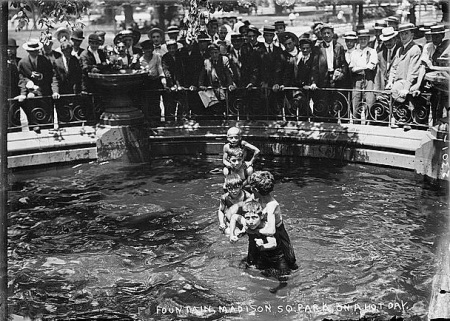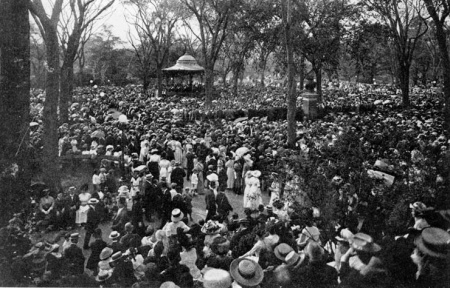 Today we survive summer heat waves with air conditioning and gelato runs.
Today we survive summer heat waves with air conditioning and gelato runs.
But the “can’t-get-aways” of the 19th century city had to rely on other ways to keep cool, reports this cheeky New York Times Illustrated Magazine article from July 23, 1899.
One tactic was to loiter near electric fans: in offices, barber shops, and restaurants.
“When [fan loiterers] find a fan that suits them they plant themselves, so to speak, and remain as long as possible in placid enjoyment of the breezes furnished by other people’s money,” wrote the Times.

“Every proprietor of an electric fan becomes acquainted during the heated term with these electric fan fiends.”
Some people engaged in “violent exercise.” These are the “misguided people who, given a temperature of a hundred in the shade, will choose a century run on a bicycle as the most enjoyable way of passing the time.”
Golf, baseball, and tennis “also have their enthusiastic hot-weather devotees, as a visit to Central Park any afternoon will testify.”

Socializing on a roof garden was an option, or heading to the mall at Central Park to hear free music, or splashing around “gleefully as dolphins” in the fountain at City Hall Park—though the latter was reserved for newsboys.
You could always catch a cool breeze by riding streetcars, transferring from car to car to the farthest and coolest parts of the city.
“The happiest man of the season is one who has just discovered that he can ride from the Battery up to Hastings-on-Hudson for 8 cents,” states the Times.
 Then there was the “soda water habit,” which caused afflicted people to guzzle all kinds of creamy, bubbly concoctions and risk “dyspepsia.”
Then there was the “soda water habit,” which caused afflicted people to guzzle all kinds of creamy, bubbly concoctions and risk “dyspepsia.”
Finally, the article took New Yorkers to task for dressing inappropriately.
“Young professional men get an idea that dignity is a matter of dress, and go about on hot days wearing high silk hats and frock coats that give one a high fever only to look at them.

“It is true that lanky young men with very lean calves affect knickerbockers in Summer, and stout elderly women appear in light, airy muslins that would be suitable for slender girls of sixteen, but beyond this, and the general appearance of straw hats and shirt waists, there are few indications in the dress of New Yorkers that Summer is with us.”
[Photos: soda water ad, NYPL; splashing in the fountain at Madison Square Park, LOC; the roof garden at the Ritz-Carlton, NYPL; a street car with open windows, NYPL; a free summer concert on the mall, NYC Parks Department]




























